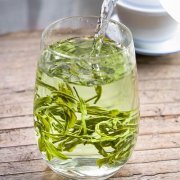What kind of tea set do you use to make black tea? do not use purple sand pot to make tea.
When learning to be certified as a tea master, use the Chinese kungfu tea ceremony as the format for tasting and evaluating tea.
It teaches you to use all your senses to appreciate tea-the feeling, appearance, texture and aroma of dried leaves, tea soup and wet leaves.
I have been taking advantage of every opportunity to prepare tea in this way, especially at the monthly tea tasting.
You might say that I have become an insatiable leaf sniffer. Dry leaves, wet leaves... Never mind. Put a pile of tea in front of me. I want to smell them. I really can't help it!
Now, anyway, before I get certified, I am no stranger to drinking tea! I am no longer a child, and I have spent most of my life drinking tea-albeit in the traditional Western way of brewing and drinking.
Since 1983, I have served afternoon tea for my guests every day. Over the years, I have collected some beautiful little teapots.

However, I have to admit that I find the actual tea a bit annoying. I am proud that I use high-quality bulk tea, but what is the use of those pesky tea leaves before the removable filter brewer? They always manage to end up in my cup or hopelessly clog the spout.
Of course, it gives me an excellent opportunity to use my beautiful sterling silver filter, but it still is. Needless to say, at the end of our little party, my high-quality bulk tea usually tastes bitter because it is always boiled in hot water. And wipe the teapot dirty and messy! Leaves are everywhere!
My new appreciation of tea and the Chinese way of cooking tea is accompanied by a whole new set of tea sets-kettles, spoons, brewers, timers, thermometers, gauges, Chinese and Yixing teapots, large pots and Japanese tea sets.
I bought everything you can say! I'll never overbrew my tea again. Not only have I discovered the art of tea, for me, it has actually become a science.
For this reason, until recently, I was very opposed to using French tea presses to make tea. I like coffee, but I don't like tea. Why? Because I am determined not to let the tea boil in water for a long time.
In my experience, this tends to make the tea bitter. Just pressing the tea to the bottom of the pot won't solve the problem unless you finish all the tea immediately or pour it into a drinking kettle. Service pitcher? Duuuuhhh! Not rocket science! I have been preparing tea kung fu style for a long time and have been able to come up with this! Sometimes it takes me a while to understand the obvious.)

Now, not only have I found the tea press, but it has also become my preferred way to brew a small amount of tea. My favorite is the 12-ounce tea press from the north bank.
It is the right size for our nightly green or white tea rituals. It's really simple! Prepare your tea just like you would in any other teapot. When you use this cute little pressure cooker, I suggest you prepare a warm kettle or teapot.
In the specified time, press the piston and pour your tea into your cup. All the leftovers should be poured into your pitcher. The beauty of this method is that-like any glass teapot-you can see the leaves spread out gracefully in the water, magically releasing their essence. With each irrigation, the leaves get bigger, until at last they seem to fill the whole pot.
You might say that this little performance has become the highlight of my nightly ceremony. In fact (I have OCD) it has become my new obsession!
Important Notice :
前街咖啡 FrontStreet Coffee has moved to new addredd:
FrontStreet Coffee Address: 315,Donghua East Road,GuangZhou
Tel:020 38364473
- Prev

What are the most famous high-end brands of Darjeeling black tea? How do you drink Royal Darjeeling black tea?
Winter Darjeeling is Darjeeling Tea's tea that harvests earlier than the first tea in a year. Picking Darjeeling in winter is not common and only a few estates are produced, such as Arya Arya Manor. Dongji Darjeeling is regarded by many tea lovers as black tea that has attracted a lot of attention and everyone wants it. In addition, not only because the quality of winter picking Darjeeling is very unique, but also because of it
- Next

What kind of tea is white tea? How to distinguish between white tea and green tea which is more refreshing? The origin story of tea
While the world of tea may seem wonderful, and people don't have to argue about the health gifts it brings, many of us still wonder about the difference between green and white tea. So, what exactly is green tea Vs white tea? Let's keep reading! Tea is one of the oldest and most popular hot drinks, has been around for centuries and is still popular around the globe. World's
Related
- Why can American refills for free? The difference between Americano and American drip pot coffee
- Being chased out of the rain in front of Starbucks?! Store: Sheltering from rain under umbrellas poses a safety hazard
- The white moonlight has changed?! Lucky launches "Big Winter Pear American"
- Hand-brewed coffee three-stage method, high-sweet and universal brewing method to share! What does the high sweet water level of hand-brewed coffee mean?
- What is the difference between raw, refined and full espresso coffee? How to extract espresso and taste good?
- A complete list of coffee bean names and their meanings! What is Yejia Shefi coffee? Where is Mantelin coffee?
- What grade does Arida Manor Kaduai coffee beans belong to? What treatment is Arida ASD slow anaerobic sun exposure?
- The milk tea cup becomes smaller?! Overlord Tea Girl launches a new "Return to Yunnan" series
- Accused of selling counterfeit and high-priced coffee beans! Well-known boutique coffee brand "Oukelao" bowed and apologized!
- How to make espresso dumplings? Can I eat coffee and glutinous rice balls together?

